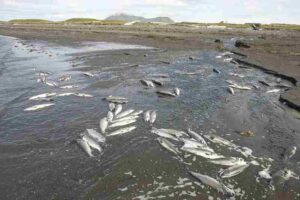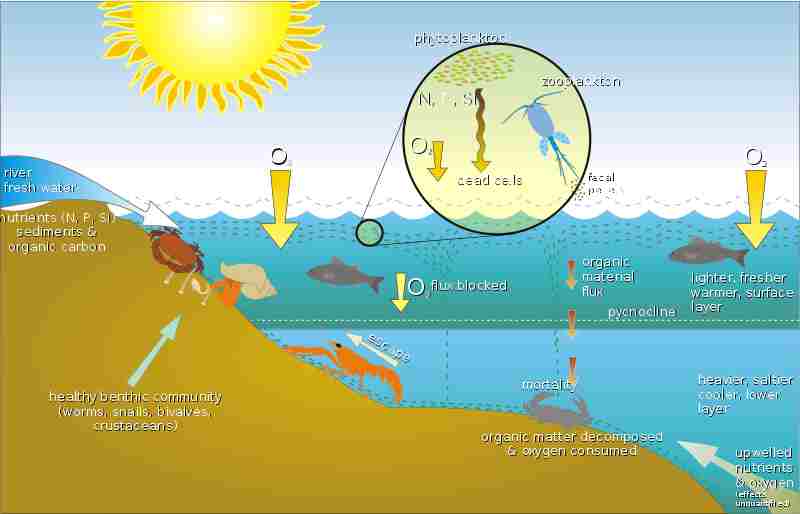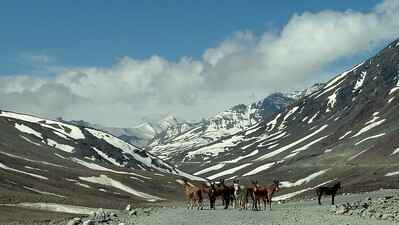7 Abiotic Factors in a Lake and Their Characteristics Discussed
Abiotic factors in a lake are; water, dissolved gases, light, physicochemical conditions, flow-trend (and velocity), sedimentary substrate, and nutrients.
This article discusses abiotic factors in a lake ecosystem, and their characteristics, as follows;
1). Water (as one of the Abiotic Factors in a Lake)
Water plays a critical role in lake ecosystems, and influences the overall species richness, biodiversity, and functioning of lacustrine environments.
As an abiotic factor in lake ecosystems, water can be discussed within the contexts of habitat-provision, nutrient-cycling, oxygenation, temperature regulation, hydrological cycling and light penetration.
1. Habitat Provision by Water in Lakes
Water is the ambient medium, and main habitat in lake ecosystems.
It provides the conditions necessary for the survival and thriving of aquatic organisms.
Water in lakes, supports diverse range microbes, plants and animals.
2. Nutrient-Cycling in the Water Column of Lakes
Water is also the medium in which nutrients are translocated and recycled within the lake ecosystem.
It facilitates the transport of dissolved nutrients like phosphorus and nitrogen, which are crucial for the growth of freshwater primary producers like aquatic macrophytes and algae [8], and help sustain the freshwater food chain.
Nutrient cycling and availability, both influence the trophic dynamics and productivity of the entire lake ecosystem.
3. Oxygenation in the Water Column of Lakes
Water has a crucial role to play in oxygenation, which is itself a critical process because dissolved oxygen is needed by aquatic organisms for survival.
The oxygen cycle in lakes proceeds within a hydrological context, and is directly influences by water flow and physicochemical conditions.
Oxygen enters into lakes through various means that include autotrophic photosynthesis (by aquatic plants, cyanobacteria and algae), wind and water-current mixing, and atmospheric exchange.
Adequate levels of oxygen supply are important for respiration of invertebrates and fish, among other organisms.

4. Temperature Regulation by Water in Lake Ecosystems
The specific heat capacity of water is relatively high, and allows it absorb and retain significant quantities of heat.
This attribute is essential for regulating the temperature of lake ecosystems, and for maintaining relatively-stable thermal conditions by buffering against excessive and rapid fluctuations in temperature.
Temperature influences the behavior; distribution and metabolic rates of aquatic organisms. It is in turn influenced by water, which is the ambient medium, in aquatic ecosystems like lakes.
5. Water and the Hydrological Cycling Concept in Lakes
Water in lake ecosystems, is the core component of the larger, regional hydrological cycle.
Processes like condensation, precipitation and evaporation, are behind the hydrological cycle in lake-inhabited areas; and lead to the continuous replenishment or recharge of these water bodies through runoff and rainfall.
The hydrological cycle links lakes to other ecosystems (including terrestrial biomes like forests and water bodies like rivers), influencing water levels, quality and availability.
6. Link Between Lake Water and Light Penetration
Water in lakes, usually functions as a sunlight-filter, which influences the distribution as well as penetration of light in the entire water body.
The availability of light is essential in photosynthesis, which is the process behind primary production in the lake ecosystem.
Algae and plant abundance (and distribution) are directly influenced by the depth to which light can penetrate, which subsequently affects the entire food chain/web.
Summary on Water as One of the Abiotic Factors in A Lake Ecosystem
Water is an essential component of lake ecosystems, because it serves as an ambient medium, and provides the necessary chemical and physical conditions for life.
It supports oxygenation, temperature regulation, nutrient-cycling and light availability; and also links the lake ecosystem to the larger hydrological cycle.
An understanding of the dynamics of water in relation to lake ecosystems is important for their conservation, management, and assessment.
2). Dissolved Gases
Dissolved gases have a critical role to play in lake ecosystems, especially dissolved oxygen.
Below are some key concepts related to dissolved gases in lakes.
*Dissolved Oxygen in Lake Ecosystems
Dissolved oxygen (DO) is an important gas in lake ecosystems.
It is required for the survival of aquatic organisms, supporting their metabolism and respiration.
There are various sources of DO in lakes, including aquatic-plant photosynthesis [11], wind and water current-mixing, and atmospheric gas exchange.
The presence of sufficient levels of dissolved oxygen in the water column, is essential for the health, sustainability and survival of invertebrates and fish, among other organisms.
*Oxygen Depletion in Lakes
Oxygen depletion may occur in lake ecosystems as a result of some factors like; excessive algal growth, eutrophication, and large-scale underwater biodegradation.
These processes have significant demand for oxygen, and can lead to oxygen-resource depletion, which is detrimental to aquatic life.
Oxygen depletion can result in biodiversity loss in the form of fish kills [2], and may negatively affect the overall health of the lake ecosystem.

*Other Dissolved Gases in Lake Ecosystems
Other gases besides oxygen can occur in lake ecosystems, such as nitrogen gas (N2), methane (CH4), and carbon dioxide (CO2) [6].
These gases vary on their concentrations, depending on factors such as rates of decomposition, respiration and photosynthesis; as well as availability of nutrients.
Changes in the concentrations of dissolved gases, can have impacts on the overall dynamics and functioning of the lake ecosystem.
*Status of Oxygen as a Biotic Factor
Dissolved oxygen is considered an abiotic factor, because it is inorganic, and plays a role toward the sustenance of its environment.
Abiotic factors are the non-living components of the ecosystem, that affect the abundance and distribution of organisms.
Dissolved oxygen, as a chemical/physical parameter of the water, affects the adaptation, spatial distribution, and survival of aquatic organisms. It is an essential abiotic factor for the functioning of lake ecosystems.
In summary, dissolved gases, like dissolved oxygen; are important to the sustainability of lake ecosystems.
Adequate dissolved oxygen levels are necessary for aquatic organisms' survival, while oxygen depletion can be detrimental.
Evaluating and understanding the dynamics of dissolved gases are important measures for assessing the functioning, and health of lake ecosystems as well as their impact on organisms that inhabit them.
3). Light (as one of the Abiotic Factors in a Lake)
Light is a critical abiotic factor in lakes, and influences various aspects of the aquatic ecosystem.
Some important concepts related to light in lake ecosystems, are discussed below;
*Photosynthesis in Lakes
Light (from solar radiation) is the main source of energy for photosynthesis; which enables autotrophs like algae and aquatic plants to transform light energy, carbon dioxide and water into chemical energy and biomass [3].
Photosynthesis is very important for organic matter production and oxygen cycling, in lake ecosystems.
The availability of sunlight has direct influence on the rate of photosynthesis, and also on the productivity and growth of primary producers in the aquatic food chain.
*Light Penetration in the Lake Ecosystem
The degree of light penetration into the lake-water column, directly affects the primary productivity of the ecosystem, by determining the maximum depth at which photosynthesis is possible.
Factors that influence light penetration include; presence of suspended particulates, dissolved solutes, and overall clarity of the water.
The incident angle of the solar rays on the water also influence light penetration.
In unpolluted waters with good clarity, light can penetrate to greater depths, so that submerged plants can carry out photosynthesis.
Waters with high turbidity, organic matter-content and/or pollution experience limited light penetration, so that photosynthesis is restricted mostly to surface and near-surface zones.
*Vertical Zonation of Lakes by Light
Light availability influences the vertical profile and zonation of lake ecosystems.
The distribution of different algae and plant species is also strongly influences by their light requirements and tolerances.
Euphotic zone (or photic zone) is the name given to the vertical section of the water column which light availability is highest [7]. This zone is further differentiated based on relative light intensity into segments like limnetic and littoral sub-zones.
Light is most abundant in the littoral zone, which is usually in nearshore areas.
Here, both vascular and non-vascular plants can grow..
Light is relatively limited In the limnetic zone; which usually coincides with open-water areas. Here, the dominant autotroph is usually phytoplankton.
On the overall, primary production in lake ecosystems is directly proportional to the depth of the entire euphotic zone (including littoral and limnetic sub-zones).

*Trophic Interactions and Light Availability in the Lake Ecosystem
Light availability directly influences the interactions between different aquatic organisms in the food web of lake ecosystems.
As primary producers, phytoplankton constitute the basal level of the food web/chain, and provide food for herbivores like zooplankton.
In turn, zooplankton, are prey for small fish and other consumers which feed on them, facilitating energy transfer to higher trophic levels of the food chain.
Changes in the availability and intensity of light, can affect these trophic interactions as well as the overall equilibrium and structure of the aquatic ecosystem.
4). Physicochemical Conditions
Physicochemical conditions are important toward shaping the lake ecosystems, in terms of organic and inorganic constituents.
Some vital points related to physicochemical conditions in lake ecosystems are discussed below. They may also be described as physicochemical parameters in the lake ecosystem;
*Temperature
Temperature influences growth, reproduction, and metabolic rates of aquatic organisms in lakes.
The precise influence of temperature on a given organism or specie differs with tolerance and adaptation; as different species have temperature ranges in which they have evolved and can thrive.
Due to such links, the distribution of species and life cycle events in lakes are driven by seasonal temperature changes.
*Dissolved Oxygen as a Physicochemical Parameter/Biotic Factor in Lake Ecosystems
Dissolved oxygen is a vital factor for the survival of aquatic organisms.
It is needed for respiration; which enables these organisms to extract bioenergy from organic matter.
Oxygen levels can vary from one point to another in the water column, and they are influenced by factors like organic decomposition, photosynthesis and temperature.
*pH in Lake Ecosystems
pH can be defined as a measure of the alkalinity or acidity of a medium such as water.
It is important in lake because it determines the organisms that can survive in any given water column; as well as the ecologic performance of such organisms.
Different lake species have different ranges of pH tolerance.
Alkaline or acidic conditions may also influence the availability of some nutrients, and the overall biological success of organisms.
*Nutrients/Nutrient Concentration in a Lake Ecosystem
Nutrients like phosphorus and nitrogen, are required for the growth of algae and aquatic plants, which are primary producers that supply energy to the rest of the ecosystem.
Excessively-high concentration of nutrients, often from human activities, can result in eutrophication, which is often associated with oxygen depletion, harmful overgrowth of algae, and overall disruption of ecologic balance [10].
*Turbidity as a Physicochemical Parameter in Lakes
Turbidity is a measure of the clarity or cloudiness of water, particularly with regard to the presence of suspended particles [9].
High turbidity often limits light penetration, and reduces the maximum depth at which photosynthesis can occur, so that the distribution of aquatic plants becomes relatively narrow.
*Salinity in Lake Ecosystems
Salinity is a measure of salt concentration.
It varies in lake ecosystems, so that inland freshwater lakes usually have low salinity; while saline lakes (including those linked to the ocean ecosystem), may have higher levels of salinity.
Salinity determines the types of organisms that can survive in a lake, as well as their abundance and spatial distribution.
5). Flow-Trend (and velocity) (as one of the Abiotic Factors in a Lake)
Flow trends and velocity in lake ecosystems are two related, and important factors that affect the characteristics and dynamics of these aquatic systems.
Some important concepts related to flow trend and velocity in lake ecosystems, are discussed below;
*Flow Trends in Lake Ecosystems
Flow trends can be defined as the motion and direction of water currents within a lake or other water body
The flow trend in some lakes is unidirectional, which means that water enters from one end of the water body and exits from the other.
Others have more complex flow patterns that are influenced by multiple factors like tidal currents and wind, or inflows from adjacent streams and rivers.
However, it must be noted that overall flow in lakes is very limited compared to other water bodies like rivers and streams.
*Water Velocity in Lakes
Water velocity is a measure of the speed with which water flows [1] within a lake.
Various factors can affect the flow-velocity of water in aquatic ecosystems, including outflow/inflow rates, morphology and topography of water basin, vegetation density, and wind.
In turn, water velocity affects some aspects of lakes, including sediment dynamics (erosion, transport, deposition), nutrient movement, and organism distribution.
*Stratification and Mixing With Respect to Water Flow Trend/Velocity in Lake Ecosystems
Water flow and velocity have roles to play toward the stratification and mixing of water masses within a lake.
Mixing can be described as the vertical movement of water masses due to thermodynamic effects or wind action. It facilitates the distribution of resources like nutrients, thermal energy and oxygen in the water column.
On the other hand, stratification involves the separation of water into distinct layers across the vertical extent of the water-column, as a result of spatial variations in density and temperature; which result in distinguishable layers within the lake.
*Nutrient Cycling in Lakes
Flow trends and water velocity play a vital role in nutrient cycling within lake ecosystems.
They affect the manner in which nutrients like nitrogen and phosphorus are transported from in-siyu sediments or surrounding watershed areas.
Nutrients are crucial for primary productivity, and exert influence over the growth of aquatic vascular plants, as well as algae.
*Habitat Provision and Availability
Water flow and velocity affect the provision, suitability, availability, of habitats for various organisms.
Different aquatic species have specific tolerances in terms of flow conditions, so that some species thrive in slow-moving areas and others in faster-flowing area.
Flow trends and velocity also influence the spatial distribution and overall performance of benthic organisms that dwell on the bottom of the water column [12].
6). Sedimentary Substrate
Sedimentary substrate refers to the sediments and other earth materials accumulated at the bottom of lake ecosystems.
Some important concepts related to sedimentary substrates in lakes are discussed below;
*Composition and Texture of Lake Sediments
Sedimentary substrate in lakes can vary significantly in composition and texture.
It may consist exclusively of silt, gravel, sand, humus, or a combination of these materials.
The composition and texture of sedimentary substrate influence the physical, chemical and biological properties of the lake bottom.
*Lake Sedimentary Substrate and Habitat for Benthic Organisms
The sedimentary substrate provides a habitat for various benthic organisms, including invertebrates like worms and insect larvae, as well as bottom-dwelling fish.
For these organisms, the substrate is useful for shelter and protection from predators, and also plays a role in feeding and reproduction.
*Lake Sedimentary Substrate and Nutrient Cycling
Sediments in lake ecosystems play a critical role in the cycling of nutrients.
These sediments also act as a carbon sink [5], and an accumulation medium for essential minerals as well as organic matter.
The nutrients in lake bottom-sediments can be transformed or released over time. By storing and releasing nutrients, sediments in the lake ecosystem influence primary production, overall ecological dynamics, and water quality.
*Processes of Sedimentation in Lake Ecosystems
Sedimentation is a continuous process occurring in lake ecosystems.
It comprises of sub-processes like regional erosion, runoff from surrounding watershed areas, and deposition by settling of suspended/transported particles.
Accumulation of sediments in certain areas of the lake may be influenced by factors like topography, depth/vertical extent of the water column, and rate of water flow.
*Impact of Sediments on the Clarity and Turbidity of Water in Lakes
Other abiotic factors in a lake ecosystem can be affected by sediments. One of these is turbidity, which is a measurable physicochemical parameter in lakes.
Sedimentary substrate can affect water clarity in any aquatic ecosystem.
Suspended sedimentary materials such as fine sediments, can reduce visibility and clarity, by absorbing and scattering light, which may potentially inhibit the growth of autotrophs and affect the performance of heterotrophic organisms.
*Historical Records of Sediments an Sedimentation in Lake Ecosystems
Sediments can play the role of historical archives that preserve information about evolutionary events and past environmental conditions in the lake ecosystem.
Analysis of sediment cores from lake bottoms can enable scientists to study and understand long-term ecological trends, environmental impacts of human activities, historical pollution patterns. This is similar to the derivation of information though ocean floor sampling.
7). Nutrients (as one of the Abiotic Factors in a Lake)
Nutrients are one of the most important abiotic factors in a lake ecosystem. Below are some key points in the discussion of lake nutrients;
*Nutrients in Lakes as Essential for Organic Sustenance
Nutrients like phosphorus and nitrogen, are essential for the sustenance of biotic components of lake ecosystems; in terms of survival and growth of both autotrophic and heterotrophic organisms.
They are the building blocks of important organic compounds such as nucleic acids and proteins.
*Sources of Nutrients in Lake Ecosystems
Nutrients can enter into lake ecosystems from different sources.
These include natural processes like atmospheric gas-absorption, decomposition of organic matter and weathering of rocks.
Manmade sources of nutrients in lakes include industrial plants, sewage systems and agricultural outlets. These sources are not always safe and may cause water pollution, and/or excessive nutrient accumulation, which in turn leads to eutrophication.
*Nutrient Limitation(s) in Lakes
The availability and distribution of nutrients can limit primary productivity in lakes.
In oligotrophic lakes with low productivity, it is not uncommon for nutrient availability to be also low [4], leading to low growth rates among autotrophs like algae ans aquatic plants.
On the other hand, eutrophic lakes, with high nutrient concentrations, are often characterized by excessive algal blooms, poor water quality, and oxygen depletion.
*Nutrient Availability and Trophic Cascades in Lake Ecosystems
Nutrient availability often influences the dynamics and structure of lake food chains/energy pyramids.
Changes in the level of nutrient concentration can impact the composition and abundance of primary producers, which in turn influences herbivorous consumers, predators, and decomposers. These interactions can have cascading effects throughout the entire ecosystem.
*Nutrient Cycling in Lakes
Nutrients are contained and managed in natural, biogeochemical cycles.
These cycles occur in lake ecosystems as well, and involve processes like; mineralization, decomposition, uptake by autotrophs, and consumption by heterotrophs.
Nutrient cycling to sustain the dynamic of nutrient availability and utilization in the ecosystem.
*Lake Eutrophication by Excessive Nutrients
Excessive nutrient inputs can result in eutrophication in lakes.
Features of eutrophication include poor water quality, turbidity, excessive algal growth, oxygen depletion, and unnatural changes in the composition and distribution of aquatic communities.
It can have detrimental effects on organic survival and general environmental health.
Conclusion
Abiotic factors in a lake are;
1. Water
2. Dissolved Gases
3. Light
4. Physicochemical Conditions
5. Flow-Trend (and velocity)
6. Sedimentary Substrate
7. Nutrients
References
1). Alexandrovich, A. D. (2020). "Water flow speed determining using visualization methods." Scientific Visualization 12(5). Available at: https://doi.org/10.26583/sv.12.5.09. (Accessed 15 July 2023).
2). Barica, J.; Mathias, J. A. (2011). "Oxygen Depletion and Winterkill Risk in Small Prairie Lakes Under Extended Ice Cover." Journal of the Fisheries Research Board of Canada 36(8):980-986. Available at: https://doi.org/10.1139/f79-136. (Accessed 15 July 2023).
3). Beer, S.; Wetzel, R. G. (1982). "Photosynthesis in submersed macrophytes of a temperate lake." Plant Physiol. 1982 Aug;70(2):488-92. Available at: https://doi.org/10.1104/pp.70.2.488. (Accessed 15 July 2023).
4). Bertoni, R.; Callieri, C.; Balseiro, E.; Modenutti, B. (2008). "Susceptibility of bacterioplankton to nutrient enrichment of oligotrophic and ultraoligotrophic lake waters." Journal of Limnology 67(2):120-127. Available at: https://doi.org/10.4081/jlimnol.2008.120. (Accessed 15 July 2023).
5). Campbell, I.; Campbell, C.; Vitt, D. H.; Kelker, D.; Laird, L. D.; Trew, D.; Kotak, B.; LeClair, D.; Bayley, S. E. (2000). "A first estimate of organic carbon storage in Holocene lake sediments in Alberta, Canada." Journal of Paleolimnology 24(4):395-400. Available at: https://doi.org/10.1023/A:1008103605817. (Accessed 15 July 2023).
6). Denfeld, B.; Klaus, M.; Laidon, H.; Sponseller, R. A.; Karlsson, J. (2018). "Carbon Dioxide and Methane Dynamics in a Small Boreal Lake During Winter and Spring Melt Events." Journal of Geophysical Research: Biogeosciences 123(6). Available at: https://doi.org/10.1029/2018JG004622. (Accessed 15 July 2023).
7). Ehrenfels, B.; Bartosiewicz, M.; Mbonde, A.; Baumann, K. B. L.; Dinkel, C.; Junker, J.; Kamulali, T.; Kimirei, I.; Odermatt, D.; Pomati, F.; Emmanuel, S. A.; Wehrli, B. (2020). "Thermocline depth and euphotic zone thickness regulate the abundance of diazotrophic cyanobacteria in Lake Tanganyika." Available at: https://doi.org/10.5194/bg-2020-214. (Accessed 15 July 2023).
8). Li, M.; Li, Y.; Zhang, Y.; Xu, Q.; Iqbal, M. S.; Xi, Y.; Xiang, X. (2022). "The significance of phosphorus in algae growth and the subsequent ecological response of consumers." Journal of Freshwater Ecology 37(1):57-69. Available at: https://doi.org/10.1080/02705060.2021.2014365. (Accessed 15 July 2023).
9). Omar, A. F.; Matjafri, M. Z. (2009). "Turbidimeter design and analysis: a review on optical fiber sensors for the measurement of water turbidity." Sensors (Basel). 2009;9(10):8311-35. Available at: https://doi.org/10.3390/s91008311. (Accessed 15 July 2023).
10). Rathore, S. S.; Chandravanshi, P.; Chandravanshi, A.; Jaiswal, K. (2016). "Eutrophication: Impacts of Excess Nutrient Inputs on Aquatic Ecosystem." IOSR Journal of Agriculture and Veterinary Science 09(10):89-96. Available at: https://doi.org/10.9790/2380-0910018996. (Accessed 15 July 2023).
11). Shadrin, N.; Anufriieva, E.; Latushkin, A.; Prazukin, A.; Yakovenko, V. (2022). "Daily Rhythms and Oxygen Balance in the Hypersaline Lake Moynaki (Crimea)." Water 2022, 14, 3753. Available at: https://doi.org/10.3390/w14223753. (Accessed 15 July 2023).
12). Wegscheider, B.; Monk, W.; Lento, J.; Haralampides, K.; Ndong, M.; Linnansaari, T.; Curry, R. A. (2023). "Developing environmental flow targets for benthic macroinvertebrates in large rivers using hydraulic habitat associations and taxa thresholds." Ecological Indicators 146(1–3):109821. Available at: https://doi.org/10.1016/j.ecolind.2022.109821. (Accessed 15 July 2023).




